Health Priority Setting Report: Common Themes and Conclusion
VerifiedAdded on 2021/05/31
|11
|3036
|20
Report
AI Summary
This report provides a comprehensive overview of health priority setting, a crucial strategy for allocating resources in healthcare. It begins with an introduction to priority setting, explaining its significance in determining which health interventions to undertake first, and then delves into the various levels at which priority setting can be implemented, such as at the overall strategy stage, research level, and health budget stage. The report then explores health interventions, which aim to improve physical and mental health, and identifies key implementers involved in the process. Chapter 2 focuses on factors that influence priority setting, including data comparison, government priorities, financial costs, and the potential for improvement. The report also highlights common themes for good practice in health research priority setting, emphasizing preparatory work, comprehensive approaches, and the importance of stakeholder involvement. It concludes by underscoring the collaborative nature of priority setting, emphasizing transparency, information, and commitment. The report also includes a checklist for health research priority setting and references for further reading.
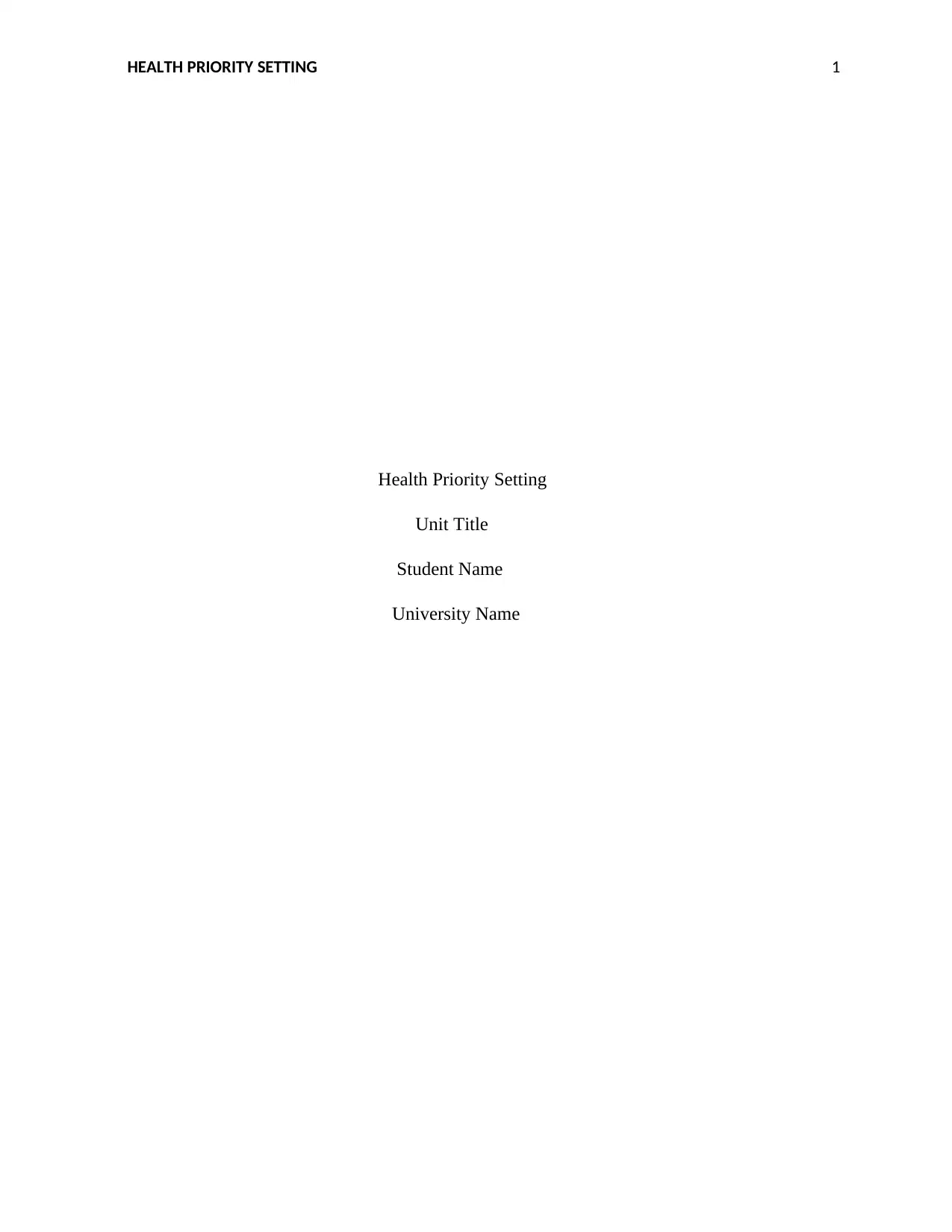
HEALTH PRIORITY SETTING 1
Health Priority Setting
Unit Title
Student Name
University Name
Health Priority Setting
Unit Title
Student Name
University Name
Paraphrase This Document
Need a fresh take? Get an instant paraphrase of this document with our AI Paraphraser
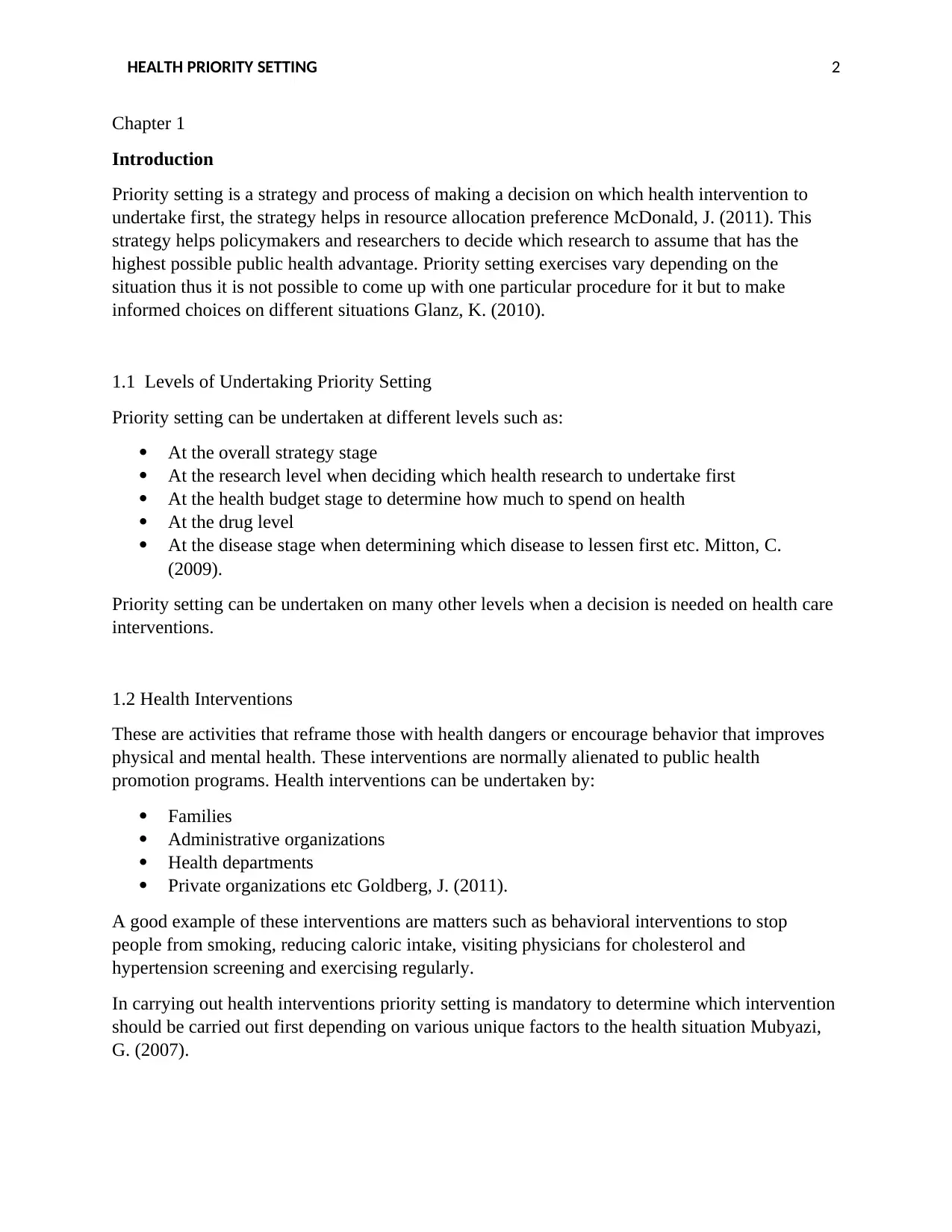
HEALTH PRIORITY SETTING 2
Chapter 1
Introduction
Priority setting is a strategy and process of making a decision on which health intervention to
undertake first, the strategy helps in resource allocation preference McDonald, J. (2011). This
strategy helps policymakers and researchers to decide which research to assume that has the
highest possible public health advantage. Priority setting exercises vary depending on the
situation thus it is not possible to come up with one particular procedure for it but to make
informed choices on different situations Glanz, K. (2010).
1.1 Levels of Undertaking Priority Setting
Priority setting can be undertaken at different levels such as:
At the overall strategy stage
At the research level when deciding which health research to undertake first
At the health budget stage to determine how much to spend on health
At the drug level
At the disease stage when determining which disease to lessen first etc. Mitton, C.
(2009).
Priority setting can be undertaken on many other levels when a decision is needed on health care
interventions.
1.2 Health Interventions
These are activities that reframe those with health dangers or encourage behavior that improves
physical and mental health. These interventions are normally alienated to public health
promotion programs. Health interventions can be undertaken by:
Families
Administrative organizations
Health departments
Private organizations etc Goldberg, J. (2011).
A good example of these interventions are matters such as behavioral interventions to stop
people from smoking, reducing caloric intake, visiting physicians for cholesterol and
hypertension screening and exercising regularly.
In carrying out health interventions priority setting is mandatory to determine which intervention
should be carried out first depending on various unique factors to the health situation Mubyazi,
G. (2007).
Chapter 1
Introduction
Priority setting is a strategy and process of making a decision on which health intervention to
undertake first, the strategy helps in resource allocation preference McDonald, J. (2011). This
strategy helps policymakers and researchers to decide which research to assume that has the
highest possible public health advantage. Priority setting exercises vary depending on the
situation thus it is not possible to come up with one particular procedure for it but to make
informed choices on different situations Glanz, K. (2010).
1.1 Levels of Undertaking Priority Setting
Priority setting can be undertaken at different levels such as:
At the overall strategy stage
At the research level when deciding which health research to undertake first
At the health budget stage to determine how much to spend on health
At the drug level
At the disease stage when determining which disease to lessen first etc. Mitton, C.
(2009).
Priority setting can be undertaken on many other levels when a decision is needed on health care
interventions.
1.2 Health Interventions
These are activities that reframe those with health dangers or encourage behavior that improves
physical and mental health. These interventions are normally alienated to public health
promotion programs. Health interventions can be undertaken by:
Families
Administrative organizations
Health departments
Private organizations etc Goldberg, J. (2011).
A good example of these interventions are matters such as behavioral interventions to stop
people from smoking, reducing caloric intake, visiting physicians for cholesterol and
hypertension screening and exercising regularly.
In carrying out health interventions priority setting is mandatory to determine which intervention
should be carried out first depending on various unique factors to the health situation Mubyazi,
G. (2007).
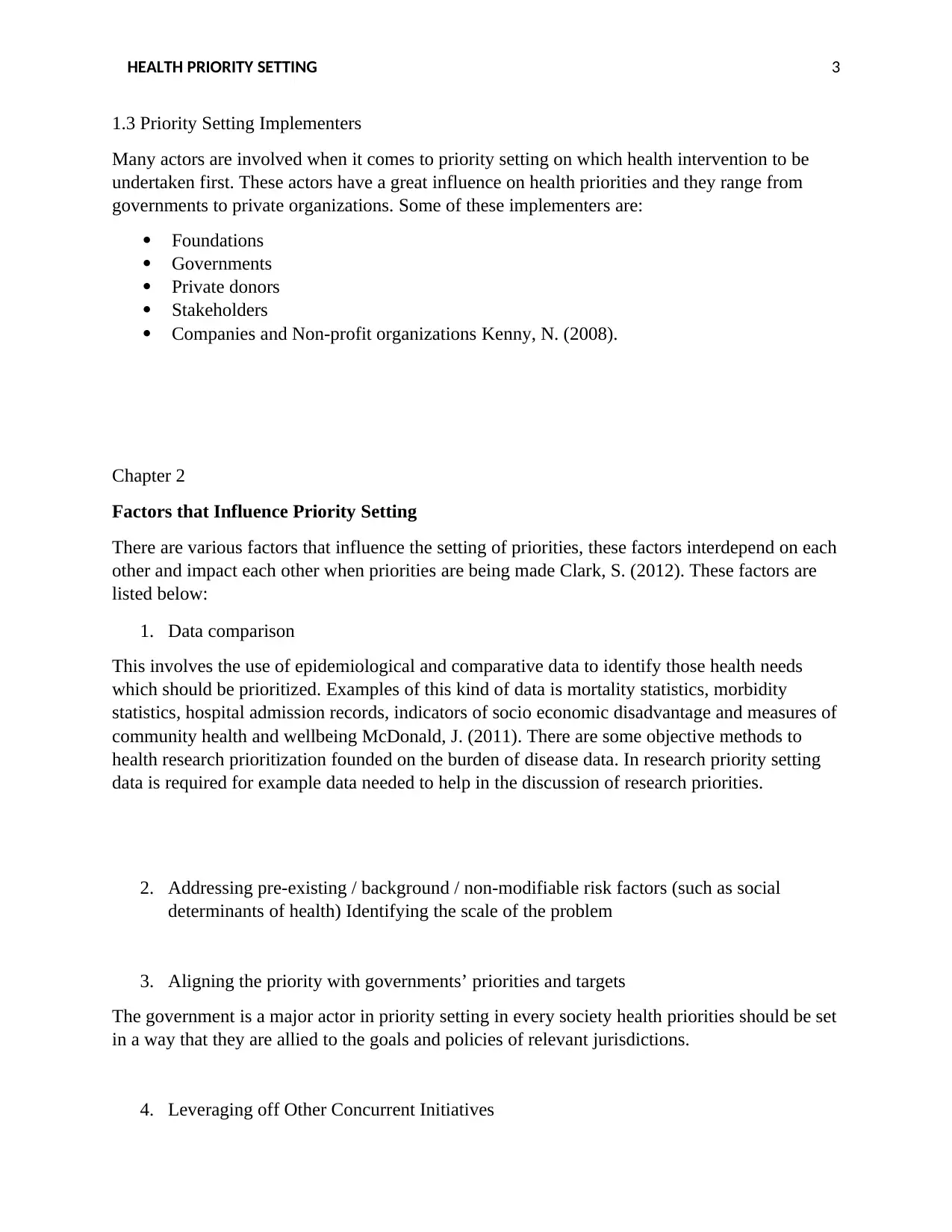
HEALTH PRIORITY SETTING 3
1.3 Priority Setting Implementers
Many actors are involved when it comes to priority setting on which health intervention to be
undertaken first. These actors have a great influence on health priorities and they range from
governments to private organizations. Some of these implementers are:
Foundations
Governments
Private donors
Stakeholders
Companies and Non-profit organizations Kenny, N. (2008).
Chapter 2
Factors that Influence Priority Setting
There are various factors that influence the setting of priorities, these factors interdepend on each
other and impact each other when priorities are being made Clark, S. (2012). These factors are
listed below:
1. Data comparison
This involves the use of epidemiological and comparative data to identify those health needs
which should be prioritized. Examples of this kind of data is mortality statistics, morbidity
statistics, hospital admission records, indicators of socio economic disadvantage and measures of
community health and wellbeing McDonald, J. (2011). There are some objective methods to
health research prioritization founded on the burden of disease data. In research priority setting
data is required for example data needed to help in the discussion of research priorities.
2. Addressing pre-existing / background / non-modifiable risk factors (such as social
determinants of health) Identifying the scale of the problem
3. Aligning the priority with governments’ priorities and targets
The government is a major actor in priority setting in every society health priorities should be set
in a way that they are allied to the goals and policies of relevant jurisdictions.
4. Leveraging off Other Concurrent Initiatives
1.3 Priority Setting Implementers
Many actors are involved when it comes to priority setting on which health intervention to be
undertaken first. These actors have a great influence on health priorities and they range from
governments to private organizations. Some of these implementers are:
Foundations
Governments
Private donors
Stakeholders
Companies and Non-profit organizations Kenny, N. (2008).
Chapter 2
Factors that Influence Priority Setting
There are various factors that influence the setting of priorities, these factors interdepend on each
other and impact each other when priorities are being made Clark, S. (2012). These factors are
listed below:
1. Data comparison
This involves the use of epidemiological and comparative data to identify those health needs
which should be prioritized. Examples of this kind of data is mortality statistics, morbidity
statistics, hospital admission records, indicators of socio economic disadvantage and measures of
community health and wellbeing McDonald, J. (2011). There are some objective methods to
health research prioritization founded on the burden of disease data. In research priority setting
data is required for example data needed to help in the discussion of research priorities.
2. Addressing pre-existing / background / non-modifiable risk factors (such as social
determinants of health) Identifying the scale of the problem
3. Aligning the priority with governments’ priorities and targets
The government is a major actor in priority setting in every society health priorities should be set
in a way that they are allied to the goals and policies of relevant jurisdictions.
4. Leveraging off Other Concurrent Initiatives
⊘ This is a preview!⊘
Do you want full access?
Subscribe today to unlock all pages.

Trusted by 1+ million students worldwide

HEALTH PRIORITY SETTING 4
Health priorities should complement and leverage off plans that are being affected by other
agencies.
5. Assessing the financial cost
Making priorities on which research to carry out is mandatory in order to maximize the effect of
investments particularly in resource strained places. Resources should be allocated based on
certain principles as shown in (table 2) Persad, G. (2009).
6. The potential to produce Improvement
The health program prioritized must show the possibility of creating an enhancement on the
current situation.
7. Maintaining Progress with Existing Community Health Plan Initiatives
Health priorities must be aligned to the plans for community health and must be responsive to
changes in these plans.
8. Consumer Action and Voice
Since consumers are the actual target of the health program, their voice is important and should
be put into consideration in priority setting McDonald, J. (2011).
9. Legitimacy
The projects being allocated resources and the process of allocation should all be legitimate and
transparent Persad, G. (2009).
10. Assessing the Scale of the Problem
This is the process of identifying the number of people who are indirectly and directly affected
by a certain problem. The scale of the problem is measured by the number of people affected by
the problem. Demographical and epidemiological data can be used to measure this scale, a
decision on priority setting is made based on this scale.
11. Assessing the Financial Cost of not Addressing the Problem
The financial cost of not addressing a problem should be put into perspective since it can be
costly leaving certain problems unresolved.
12. Potential to produce improvement
Health priorities should complement and leverage off plans that are being affected by other
agencies.
5. Assessing the financial cost
Making priorities on which research to carry out is mandatory in order to maximize the effect of
investments particularly in resource strained places. Resources should be allocated based on
certain principles as shown in (table 2) Persad, G. (2009).
6. The potential to produce Improvement
The health program prioritized must show the possibility of creating an enhancement on the
current situation.
7. Maintaining Progress with Existing Community Health Plan Initiatives
Health priorities must be aligned to the plans for community health and must be responsive to
changes in these plans.
8. Consumer Action and Voice
Since consumers are the actual target of the health program, their voice is important and should
be put into consideration in priority setting McDonald, J. (2011).
9. Legitimacy
The projects being allocated resources and the process of allocation should all be legitimate and
transparent Persad, G. (2009).
10. Assessing the Scale of the Problem
This is the process of identifying the number of people who are indirectly and directly affected
by a certain problem. The scale of the problem is measured by the number of people affected by
the problem. Demographical and epidemiological data can be used to measure this scale, a
decision on priority setting is made based on this scale.
11. Assessing the Financial Cost of not Addressing the Problem
The financial cost of not addressing a problem should be put into perspective since it can be
costly leaving certain problems unresolved.
12. Potential to produce improvement
Paraphrase This Document
Need a fresh take? Get an instant paraphrase of this document with our AI Paraphraser
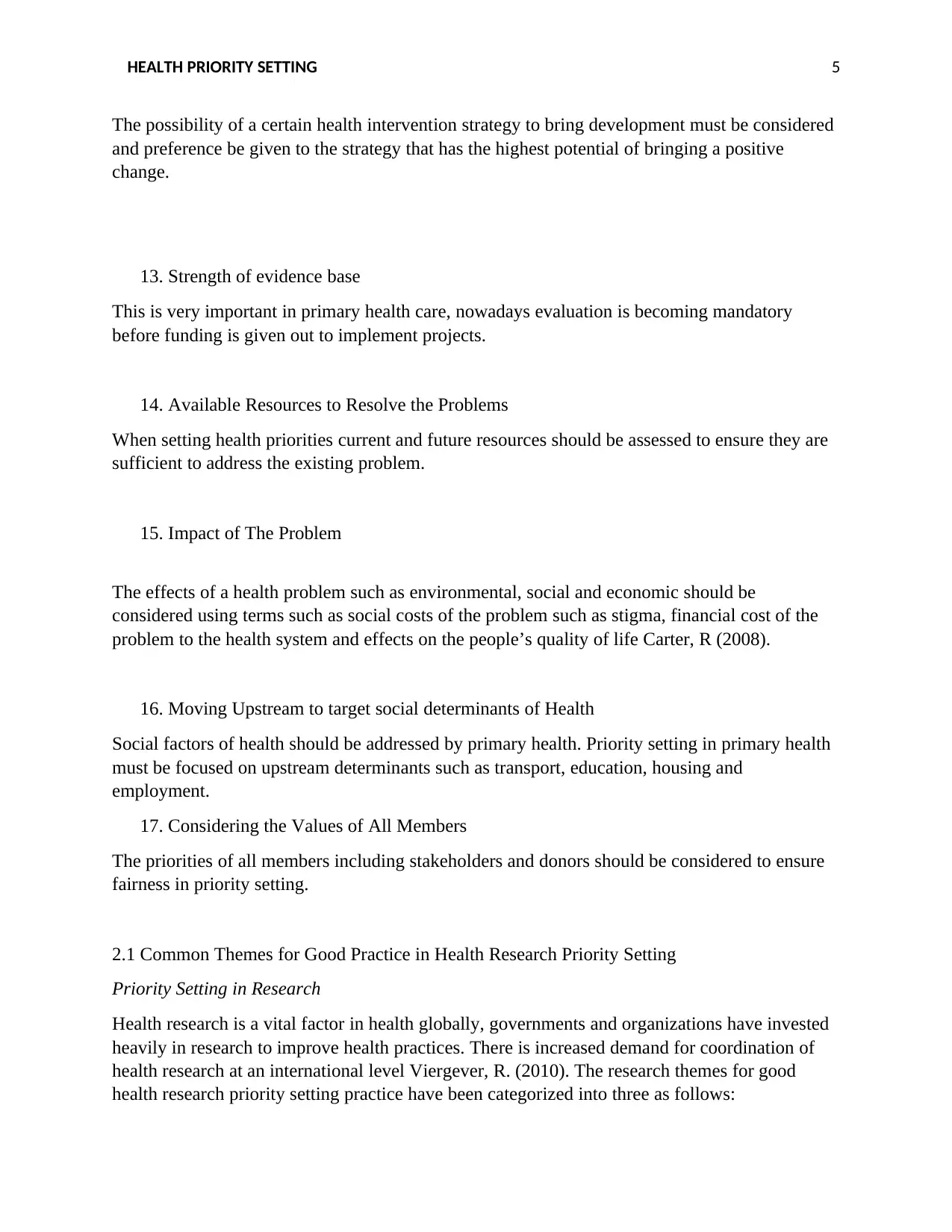
HEALTH PRIORITY SETTING 5
The possibility of a certain health intervention strategy to bring development must be considered
and preference be given to the strategy that has the highest potential of bringing a positive
change.
13. Strength of evidence base
This is very important in primary health care, nowadays evaluation is becoming mandatory
before funding is given out to implement projects.
14. Available Resources to Resolve the Problems
When setting health priorities current and future resources should be assessed to ensure they are
sufficient to address the existing problem.
15. Impact of The Problem
The effects of a health problem such as environmental, social and economic should be
considered using terms such as social costs of the problem such as stigma, financial cost of the
problem to the health system and effects on the people’s quality of life Carter, R (2008).
16. Moving Upstream to target social determinants of Health
Social factors of health should be addressed by primary health. Priority setting in primary health
must be focused on upstream determinants such as transport, education, housing and
employment.
17. Considering the Values of All Members
The priorities of all members including stakeholders and donors should be considered to ensure
fairness in priority setting.
2.1 Common Themes for Good Practice in Health Research Priority Setting
Priority Setting in Research
Health research is a vital factor in health globally, governments and organizations have invested
heavily in research to improve health practices. There is increased demand for coordination of
health research at an international level Viergever, R. (2010). The research themes for good
health research priority setting practice have been categorized into three as follows:
The possibility of a certain health intervention strategy to bring development must be considered
and preference be given to the strategy that has the highest potential of bringing a positive
change.
13. Strength of evidence base
This is very important in primary health care, nowadays evaluation is becoming mandatory
before funding is given out to implement projects.
14. Available Resources to Resolve the Problems
When setting health priorities current and future resources should be assessed to ensure they are
sufficient to address the existing problem.
15. Impact of The Problem
The effects of a health problem such as environmental, social and economic should be
considered using terms such as social costs of the problem such as stigma, financial cost of the
problem to the health system and effects on the people’s quality of life Carter, R (2008).
16. Moving Upstream to target social determinants of Health
Social factors of health should be addressed by primary health. Priority setting in primary health
must be focused on upstream determinants such as transport, education, housing and
employment.
17. Considering the Values of All Members
The priorities of all members including stakeholders and donors should be considered to ensure
fairness in priority setting.
2.1 Common Themes for Good Practice in Health Research Priority Setting
Priority Setting in Research
Health research is a vital factor in health globally, governments and organizations have invested
heavily in research to improve health practices. There is increased demand for coordination of
health research at an international level Viergever, R. (2010). The research themes for good
health research priority setting practice have been categorized into three as follows:
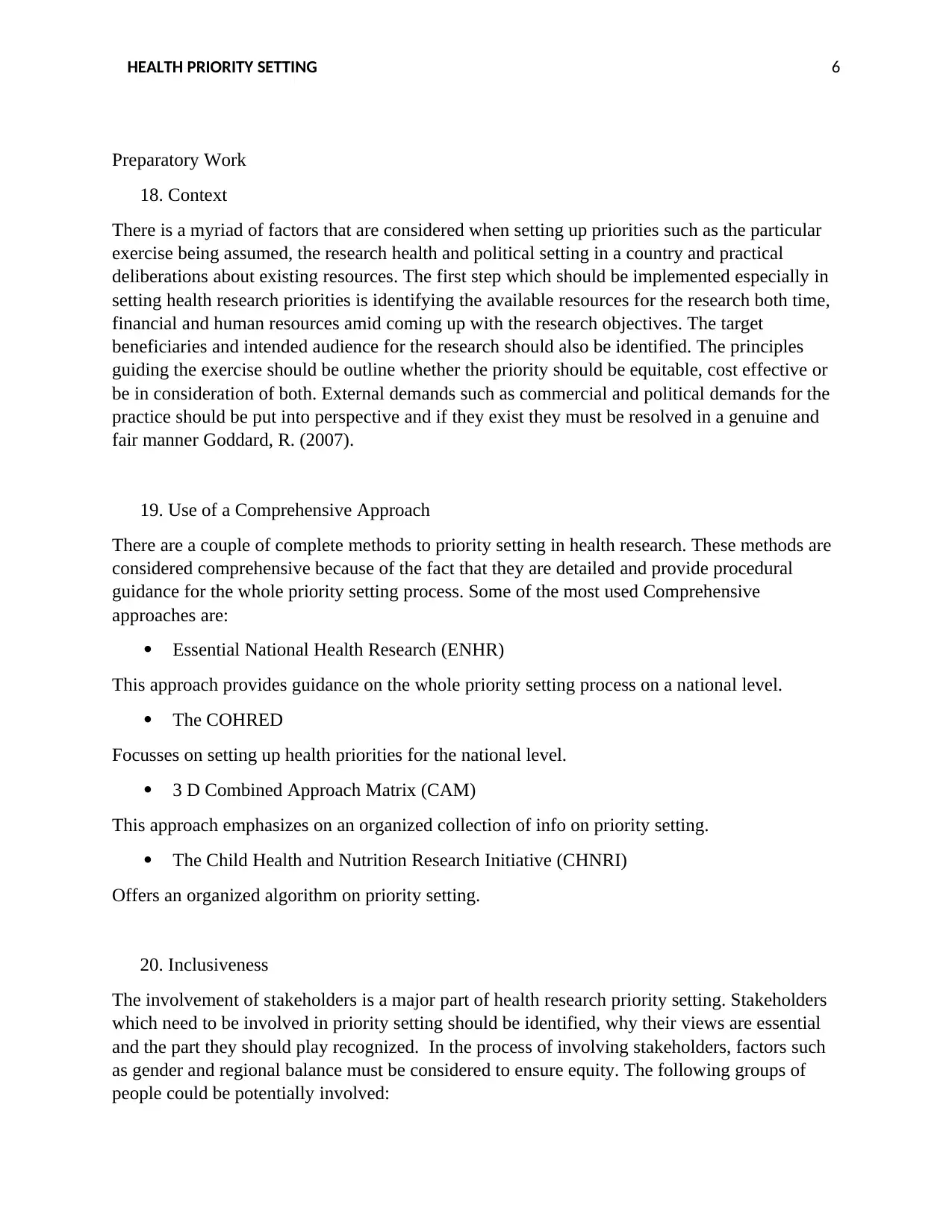
HEALTH PRIORITY SETTING 6
Preparatory Work
18. Context
There is a myriad of factors that are considered when setting up priorities such as the particular
exercise being assumed, the research health and political setting in a country and practical
deliberations about existing resources. The first step which should be implemented especially in
setting health research priorities is identifying the available resources for the research both time,
financial and human resources amid coming up with the research objectives. The target
beneficiaries and intended audience for the research should also be identified. The principles
guiding the exercise should be outline whether the priority should be equitable, cost effective or
be in consideration of both. External demands such as commercial and political demands for the
practice should be put into perspective and if they exist they must be resolved in a genuine and
fair manner Goddard, R. (2007).
19. Use of a Comprehensive Approach
There are a couple of complete methods to priority setting in health research. These methods are
considered comprehensive because of the fact that they are detailed and provide procedural
guidance for the whole priority setting process. Some of the most used Comprehensive
approaches are:
Essential National Health Research (ENHR)
This approach provides guidance on the whole priority setting process on a national level.
The COHRED
Focusses on setting up health priorities for the national level.
3 D Combined Approach Matrix (CAM)
This approach emphasizes on an organized collection of info on priority setting.
The Child Health and Nutrition Research Initiative (CHNRI)
Offers an organized algorithm on priority setting.
20. Inclusiveness
The involvement of stakeholders is a major part of health research priority setting. Stakeholders
which need to be involved in priority setting should be identified, why their views are essential
and the part they should play recognized. In the process of involving stakeholders, factors such
as gender and regional balance must be considered to ensure equity. The following groups of
people could be potentially involved:
Preparatory Work
18. Context
There is a myriad of factors that are considered when setting up priorities such as the particular
exercise being assumed, the research health and political setting in a country and practical
deliberations about existing resources. The first step which should be implemented especially in
setting health research priorities is identifying the available resources for the research both time,
financial and human resources amid coming up with the research objectives. The target
beneficiaries and intended audience for the research should also be identified. The principles
guiding the exercise should be outline whether the priority should be equitable, cost effective or
be in consideration of both. External demands such as commercial and political demands for the
practice should be put into perspective and if they exist they must be resolved in a genuine and
fair manner Goddard, R. (2007).
19. Use of a Comprehensive Approach
There are a couple of complete methods to priority setting in health research. These methods are
considered comprehensive because of the fact that they are detailed and provide procedural
guidance for the whole priority setting process. Some of the most used Comprehensive
approaches are:
Essential National Health Research (ENHR)
This approach provides guidance on the whole priority setting process on a national level.
The COHRED
Focusses on setting up health priorities for the national level.
3 D Combined Approach Matrix (CAM)
This approach emphasizes on an organized collection of info on priority setting.
The Child Health and Nutrition Research Initiative (CHNRI)
Offers an organized algorithm on priority setting.
20. Inclusiveness
The involvement of stakeholders is a major part of health research priority setting. Stakeholders
which need to be involved in priority setting should be identified, why their views are essential
and the part they should play recognized. In the process of involving stakeholders, factors such
as gender and regional balance must be considered to ensure equity. The following groups of
people could be potentially involved:
⊘ This is a preview!⊘
Do you want full access?
Subscribe today to unlock all pages.

Trusted by 1+ million students worldwide
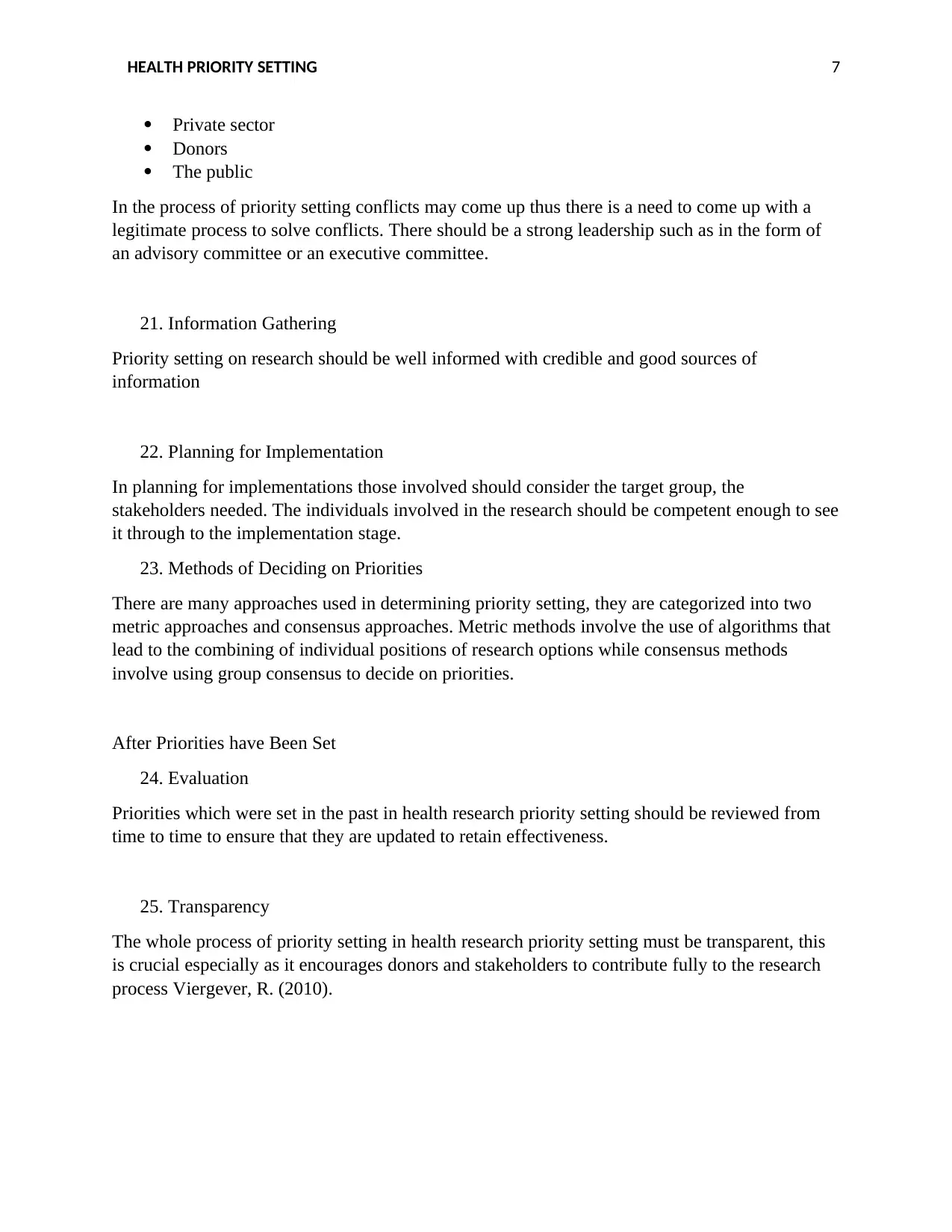
HEALTH PRIORITY SETTING 7
Private sector
Donors
The public
In the process of priority setting conflicts may come up thus there is a need to come up with a
legitimate process to solve conflicts. There should be a strong leadership such as in the form of
an advisory committee or an executive committee.
21. Information Gathering
Priority setting on research should be well informed with credible and good sources of
information
22. Planning for Implementation
In planning for implementations those involved should consider the target group, the
stakeholders needed. The individuals involved in the research should be competent enough to see
it through to the implementation stage.
23. Methods of Deciding on Priorities
There are many approaches used in determining priority setting, they are categorized into two
metric approaches and consensus approaches. Metric methods involve the use of algorithms that
lead to the combining of individual positions of research options while consensus methods
involve using group consensus to decide on priorities.
After Priorities have Been Set
24. Evaluation
Priorities which were set in the past in health research priority setting should be reviewed from
time to time to ensure that they are updated to retain effectiveness.
25. Transparency
The whole process of priority setting in health research priority setting must be transparent, this
is crucial especially as it encourages donors and stakeholders to contribute fully to the research
process Viergever, R. (2010).
Private sector
Donors
The public
In the process of priority setting conflicts may come up thus there is a need to come up with a
legitimate process to solve conflicts. There should be a strong leadership such as in the form of
an advisory committee or an executive committee.
21. Information Gathering
Priority setting on research should be well informed with credible and good sources of
information
22. Planning for Implementation
In planning for implementations those involved should consider the target group, the
stakeholders needed. The individuals involved in the research should be competent enough to see
it through to the implementation stage.
23. Methods of Deciding on Priorities
There are many approaches used in determining priority setting, they are categorized into two
metric approaches and consensus approaches. Metric methods involve the use of algorithms that
lead to the combining of individual positions of research options while consensus methods
involve using group consensus to decide on priorities.
After Priorities have Been Set
24. Evaluation
Priorities which were set in the past in health research priority setting should be reviewed from
time to time to ensure that they are updated to retain effectiveness.
25. Transparency
The whole process of priority setting in health research priority setting must be transparent, this
is crucial especially as it encourages donors and stakeholders to contribute fully to the research
process Viergever, R. (2010).
Paraphrase This Document
Need a fresh take? Get an instant paraphrase of this document with our AI Paraphraser
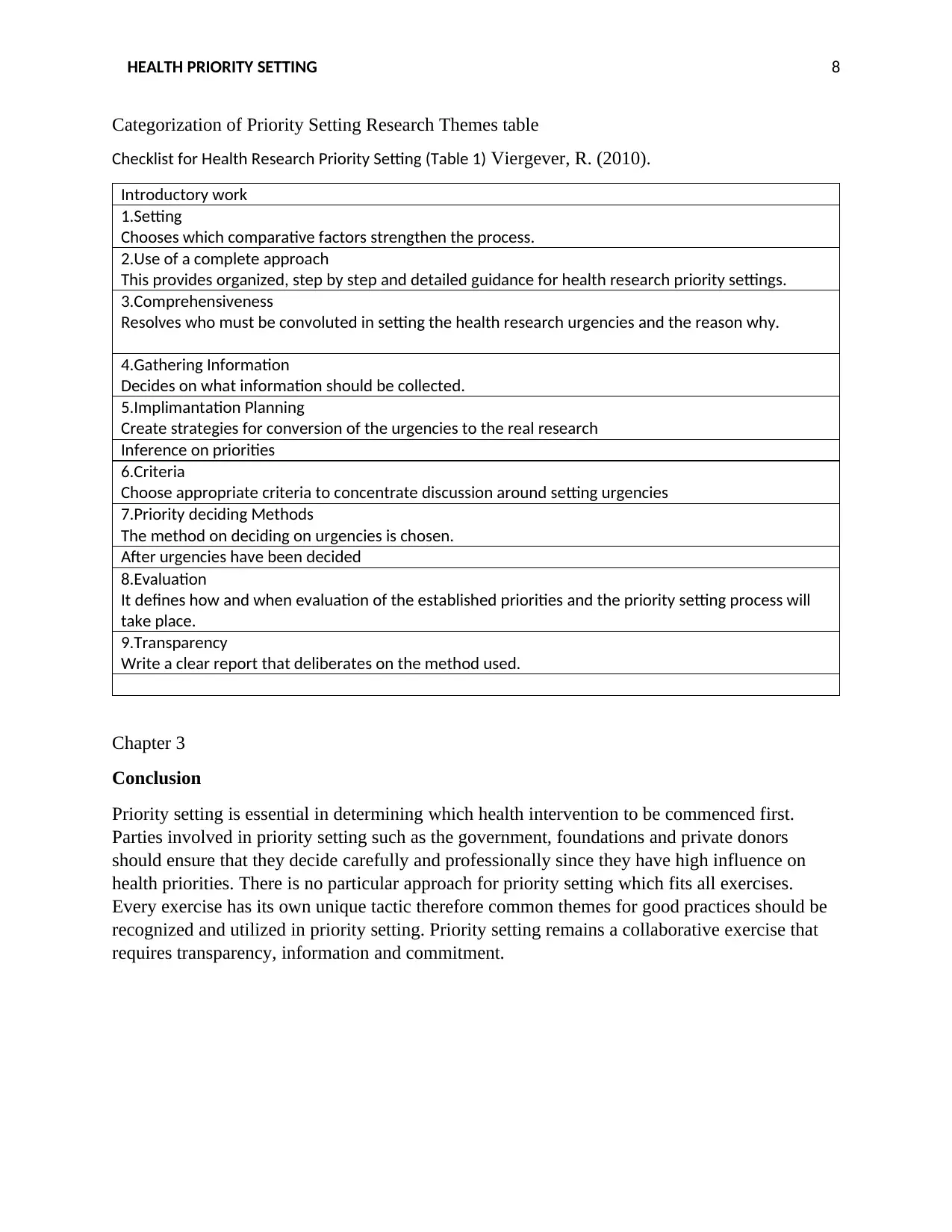
HEALTH PRIORITY SETTING 8
Categorization of Priority Setting Research Themes table
Checklist for Health Research Priority Setting (Table 1) Viergever, R. (2010).
Introductory work
1.Setting
Chooses which comparative factors strengthen the process.
2.Use of a complete approach
This provides organized, step by step and detailed guidance for health research priority settings.
3.Comprehensiveness
Resolves who must be convoluted in setting the health research urgencies and the reason why.
4.Gathering Information
Decides on what information should be collected.
5.Implimantation Planning
Create strategies for conversion of the urgencies to the real research
Inference on priorities
6.Criteria
Choose appropriate criteria to concentrate discussion around setting urgencies
7.Priority deciding Methods
The method on deciding on urgencies is chosen.
After urgencies have been decided
8.Evaluation
It defines how and when evaluation of the established priorities and the priority setting process will
take place.
9.Transparency
Write a clear report that deliberates on the method used.
Chapter 3
Conclusion
Priority setting is essential in determining which health intervention to be commenced first.
Parties involved in priority setting such as the government, foundations and private donors
should ensure that they decide carefully and professionally since they have high influence on
health priorities. There is no particular approach for priority setting which fits all exercises.
Every exercise has its own unique tactic therefore common themes for good practices should be
recognized and utilized in priority setting. Priority setting remains a collaborative exercise that
requires transparency, information and commitment.
Categorization of Priority Setting Research Themes table
Checklist for Health Research Priority Setting (Table 1) Viergever, R. (2010).
Introductory work
1.Setting
Chooses which comparative factors strengthen the process.
2.Use of a complete approach
This provides organized, step by step and detailed guidance for health research priority settings.
3.Comprehensiveness
Resolves who must be convoluted in setting the health research urgencies and the reason why.
4.Gathering Information
Decides on what information should be collected.
5.Implimantation Planning
Create strategies for conversion of the urgencies to the real research
Inference on priorities
6.Criteria
Choose appropriate criteria to concentrate discussion around setting urgencies
7.Priority deciding Methods
The method on deciding on urgencies is chosen.
After urgencies have been decided
8.Evaluation
It defines how and when evaluation of the established priorities and the priority setting process will
take place.
9.Transparency
Write a clear report that deliberates on the method used.
Chapter 3
Conclusion
Priority setting is essential in determining which health intervention to be commenced first.
Parties involved in priority setting such as the government, foundations and private donors
should ensure that they decide carefully and professionally since they have high influence on
health priorities. There is no particular approach for priority setting which fits all exercises.
Every exercise has its own unique tactic therefore common themes for good practices should be
recognized and utilized in priority setting. Priority setting remains a collaborative exercise that
requires transparency, information and commitment.
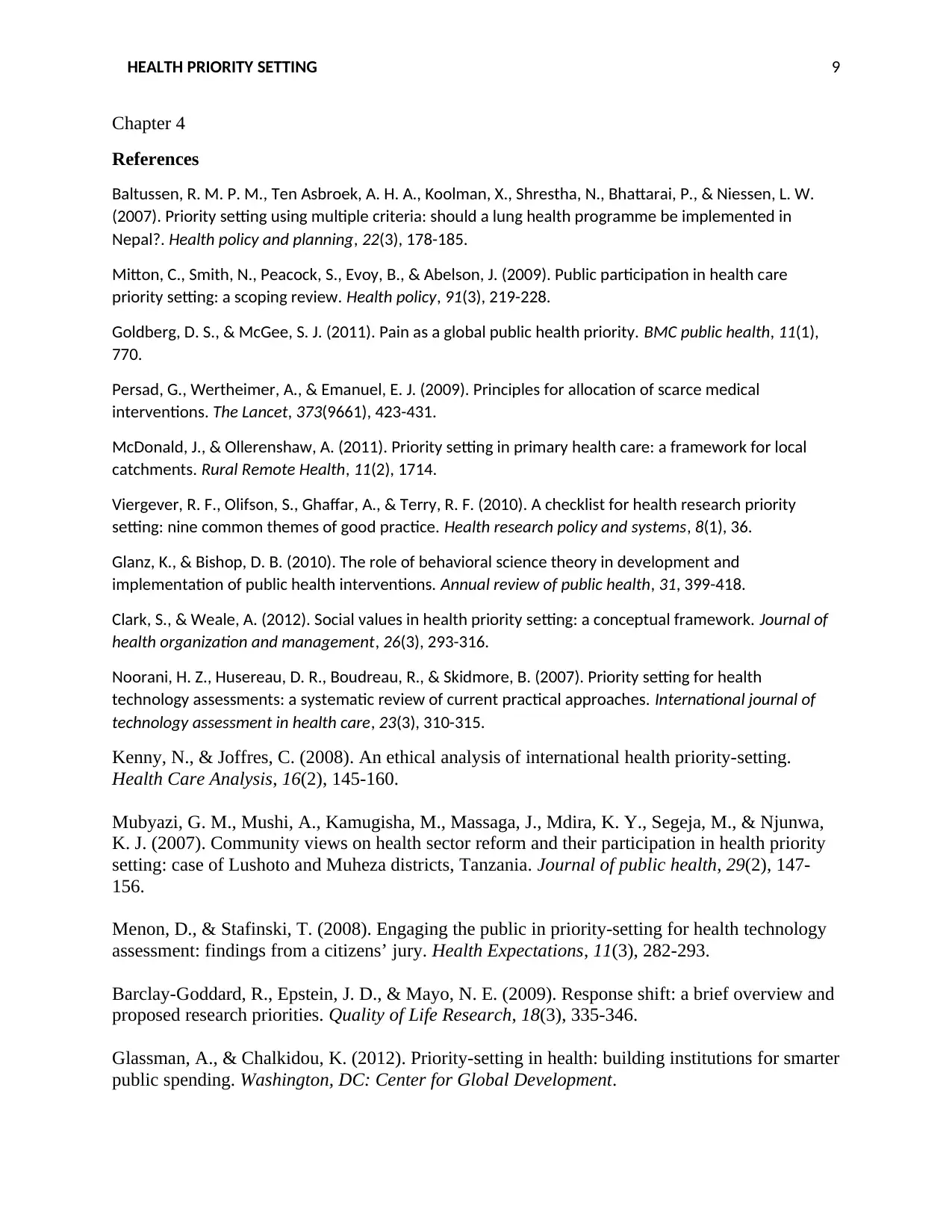
HEALTH PRIORITY SETTING 9
Chapter 4
References
Baltussen, R. M. P. M., Ten Asbroek, A. H. A., Koolman, X., Shrestha, N., Bhattarai, P., & Niessen, L. W.
(2007). Priority setting using multiple criteria: should a lung health programme be implemented in
Nepal?. Health policy and planning, 22(3), 178-185.
Mitton, C., Smith, N., Peacock, S., Evoy, B., & Abelson, J. (2009). Public participation in health care
priority setting: a scoping review. Health policy, 91(3), 219-228.
Goldberg, D. S., & McGee, S. J. (2011). Pain as a global public health priority. BMC public health, 11(1),
770.
Persad, G., Wertheimer, A., & Emanuel, E. J. (2009). Principles for allocation of scarce medical
interventions. The Lancet, 373(9661), 423-431.
McDonald, J., & Ollerenshaw, A. (2011). Priority setting in primary health care: a framework for local
catchments. Rural Remote Health, 11(2), 1714.
Viergever, R. F., Olifson, S., Ghaffar, A., & Terry, R. F. (2010). A checklist for health research priority
setting: nine common themes of good practice. Health research policy and systems, 8(1), 36.
Glanz, K., & Bishop, D. B. (2010). The role of behavioral science theory in development and
implementation of public health interventions. Annual review of public health, 31, 399-418.
Clark, S., & Weale, A. (2012). Social values in health priority setting: a conceptual framework. Journal of
health organization and management, 26(3), 293-316.
Noorani, H. Z., Husereau, D. R., Boudreau, R., & Skidmore, B. (2007). Priority setting for health
technology assessments: a systematic review of current practical approaches. International journal of
technology assessment in health care, 23(3), 310-315.
Kenny, N., & Joffres, C. (2008). An ethical analysis of international health priority-setting.
Health Care Analysis, 16(2), 145-160.
Mubyazi, G. M., Mushi, A., Kamugisha, M., Massaga, J., Mdira, K. Y., Segeja, M., & Njunwa,
K. J. (2007). Community views on health sector reform and their participation in health priority
setting: case of Lushoto and Muheza districts, Tanzania. Journal of public health, 29(2), 147-
156.
Menon, D., & Stafinski, T. (2008). Engaging the public in priority‐setting for health technology
assessment: findings from a citizens’ jury. Health Expectations, 11(3), 282-293.
Barclay-Goddard, R., Epstein, J. D., & Mayo, N. E. (2009). Response shift: a brief overview and
proposed research priorities. Quality of Life Research, 18(3), 335-346.
Glassman, A., & Chalkidou, K. (2012). Priority-setting in health: building institutions for smarter
public spending. Washington, DC: Center for Global Development.
Chapter 4
References
Baltussen, R. M. P. M., Ten Asbroek, A. H. A., Koolman, X., Shrestha, N., Bhattarai, P., & Niessen, L. W.
(2007). Priority setting using multiple criteria: should a lung health programme be implemented in
Nepal?. Health policy and planning, 22(3), 178-185.
Mitton, C., Smith, N., Peacock, S., Evoy, B., & Abelson, J. (2009). Public participation in health care
priority setting: a scoping review. Health policy, 91(3), 219-228.
Goldberg, D. S., & McGee, S. J. (2011). Pain as a global public health priority. BMC public health, 11(1),
770.
Persad, G., Wertheimer, A., & Emanuel, E. J. (2009). Principles for allocation of scarce medical
interventions. The Lancet, 373(9661), 423-431.
McDonald, J., & Ollerenshaw, A. (2011). Priority setting in primary health care: a framework for local
catchments. Rural Remote Health, 11(2), 1714.
Viergever, R. F., Olifson, S., Ghaffar, A., & Terry, R. F. (2010). A checklist for health research priority
setting: nine common themes of good practice. Health research policy and systems, 8(1), 36.
Glanz, K., & Bishop, D. B. (2010). The role of behavioral science theory in development and
implementation of public health interventions. Annual review of public health, 31, 399-418.
Clark, S., & Weale, A. (2012). Social values in health priority setting: a conceptual framework. Journal of
health organization and management, 26(3), 293-316.
Noorani, H. Z., Husereau, D. R., Boudreau, R., & Skidmore, B. (2007). Priority setting for health
technology assessments: a systematic review of current practical approaches. International journal of
technology assessment in health care, 23(3), 310-315.
Kenny, N., & Joffres, C. (2008). An ethical analysis of international health priority-setting.
Health Care Analysis, 16(2), 145-160.
Mubyazi, G. M., Mushi, A., Kamugisha, M., Massaga, J., Mdira, K. Y., Segeja, M., & Njunwa,
K. J. (2007). Community views on health sector reform and their participation in health priority
setting: case of Lushoto and Muheza districts, Tanzania. Journal of public health, 29(2), 147-
156.
Menon, D., & Stafinski, T. (2008). Engaging the public in priority‐setting for health technology
assessment: findings from a citizens’ jury. Health Expectations, 11(3), 282-293.
Barclay-Goddard, R., Epstein, J. D., & Mayo, N. E. (2009). Response shift: a brief overview and
proposed research priorities. Quality of Life Research, 18(3), 335-346.
Glassman, A., & Chalkidou, K. (2012). Priority-setting in health: building institutions for smarter
public spending. Washington, DC: Center for Global Development.
⊘ This is a preview!⊘
Do you want full access?
Subscribe today to unlock all pages.

Trusted by 1+ million students worldwide
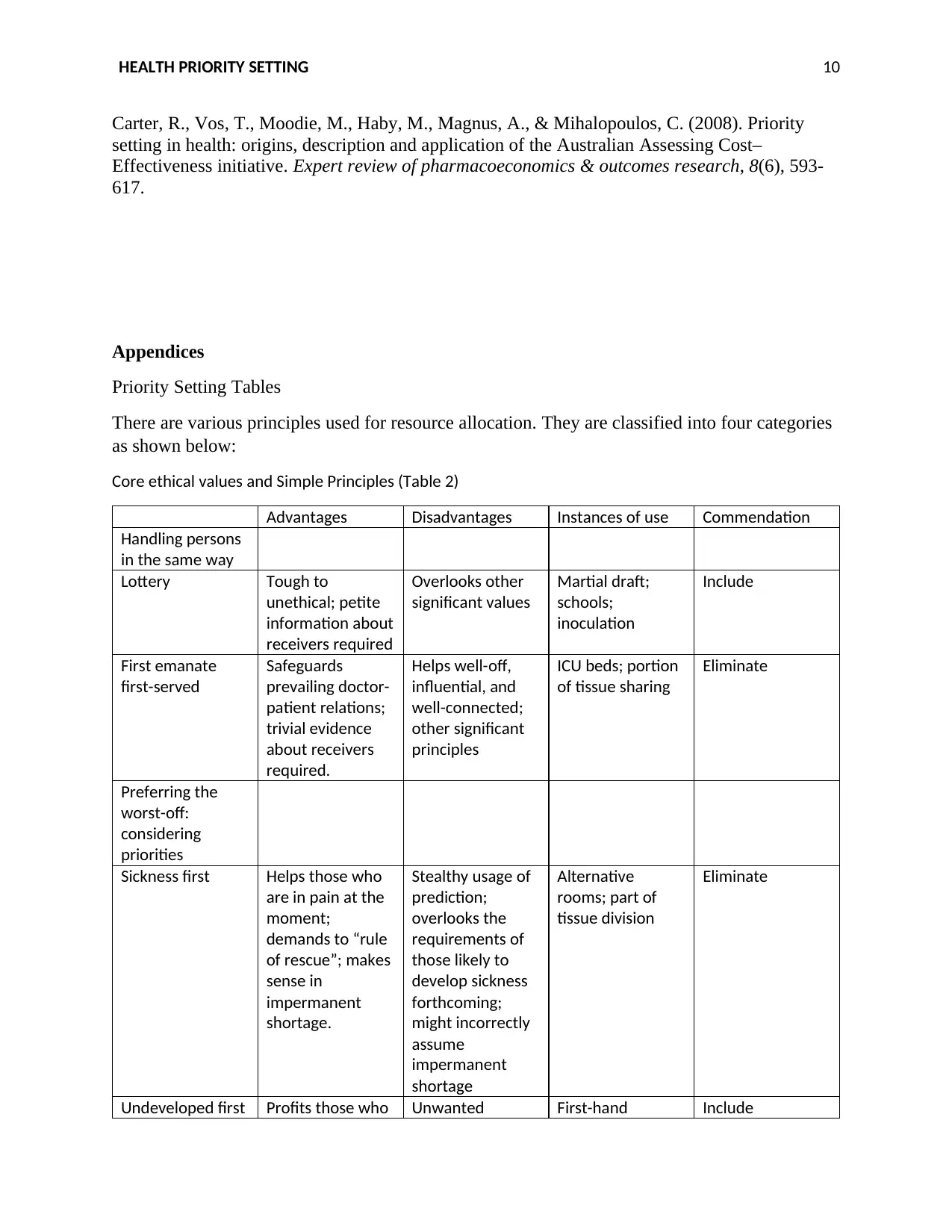
HEALTH PRIORITY SETTING 10
Carter, R., Vos, T., Moodie, M., Haby, M., Magnus, A., & Mihalopoulos, C. (2008). Priority
setting in health: origins, description and application of the Australian Assessing Cost–
Effectiveness initiative. Expert review of pharmacoeconomics & outcomes research, 8(6), 593-
617.
Appendices
Priority Setting Tables
There are various principles used for resource allocation. They are classified into four categories
as shown below:
Core ethical values and Simple Principles (Table 2)
Advantages Disadvantages Instances of use Commendation
Handling persons
in the same way
Lottery Tough to
unethical; petite
information about
receivers required
Overlooks other
significant values
Martial draft;
schools;
inoculation
Include
First emanate
first-served
Safeguards
prevailing doctor-
patient relations;
trivial evidence
about receivers
required.
Helps well-off,
influential, and
well-connected;
other significant
principles
ICU beds; portion
of tissue sharing
Eliminate
Preferring the
worst-off:
considering
priorities
Sickness first Helps those who
are in pain at the
moment;
demands to “rule
of rescue”; makes
sense in
impermanent
shortage.
Stealthy usage of
prediction;
overlooks the
requirements of
those likely to
develop sickness
forthcoming;
might incorrectly
assume
impermanent
shortage
Alternative
rooms; part of
tissue division
Eliminate
Undeveloped first Profits those who Unwanted First-hand Include
Carter, R., Vos, T., Moodie, M., Haby, M., Magnus, A., & Mihalopoulos, C. (2008). Priority
setting in health: origins, description and application of the Australian Assessing Cost–
Effectiveness initiative. Expert review of pharmacoeconomics & outcomes research, 8(6), 593-
617.
Appendices
Priority Setting Tables
There are various principles used for resource allocation. They are classified into four categories
as shown below:
Core ethical values and Simple Principles (Table 2)
Advantages Disadvantages Instances of use Commendation
Handling persons
in the same way
Lottery Tough to
unethical; petite
information about
receivers required
Overlooks other
significant values
Martial draft;
schools;
inoculation
Include
First emanate
first-served
Safeguards
prevailing doctor-
patient relations;
trivial evidence
about receivers
required.
Helps well-off,
influential, and
well-connected;
other significant
principles
ICU beds; portion
of tissue sharing
Eliminate
Preferring the
worst-off:
considering
priorities
Sickness first Helps those who
are in pain at the
moment;
demands to “rule
of rescue”; makes
sense in
impermanent
shortage.
Stealthy usage of
prediction;
overlooks the
requirements of
those likely to
develop sickness
forthcoming;
might incorrectly
assume
impermanent
shortage
Alternative
rooms; part of
tissue division
Eliminate
Undeveloped first Profits those who Unwanted First-hand Include
Paraphrase This Document
Need a fresh take? Get an instant paraphrase of this document with our AI Paraphraser
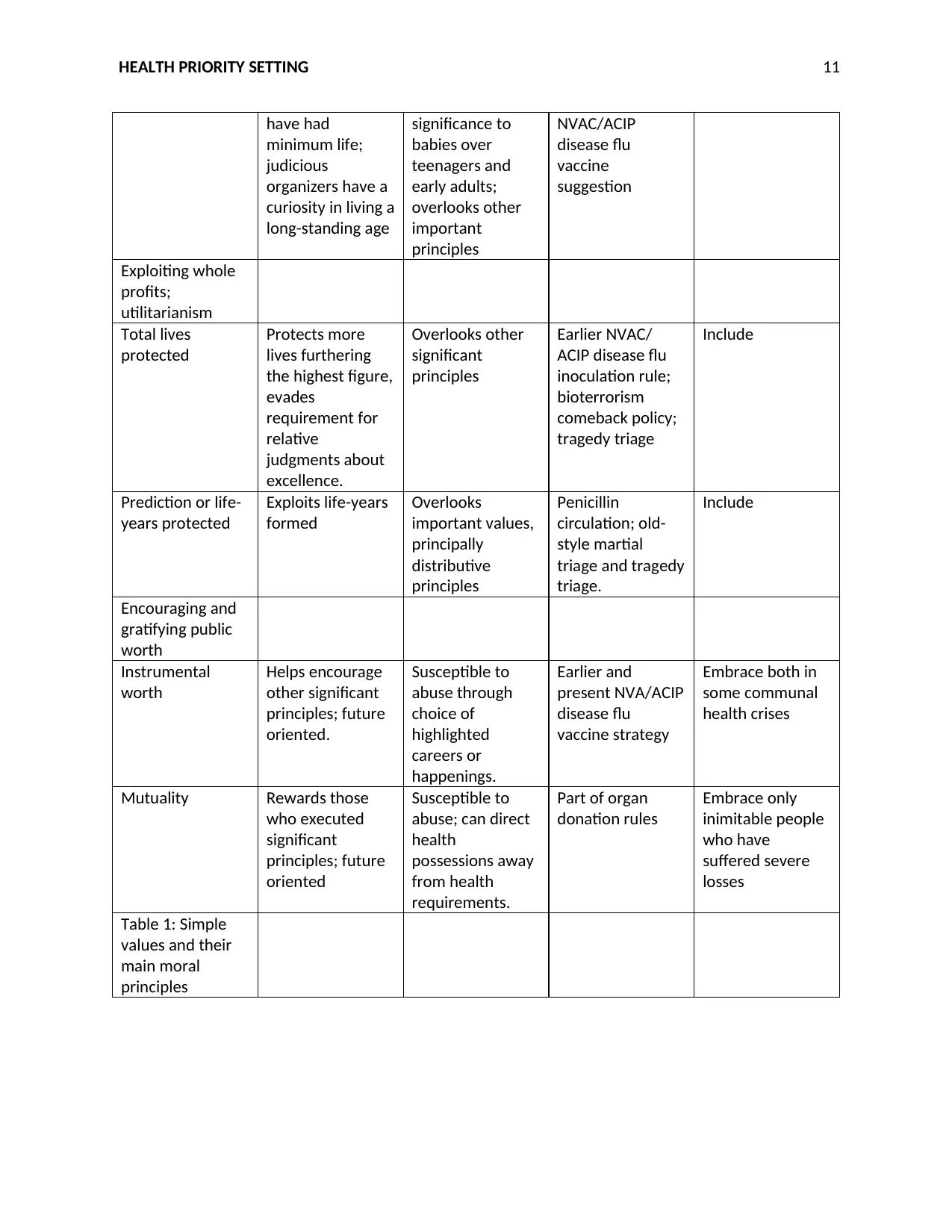
HEALTH PRIORITY SETTING 11
have had
minimum life;
judicious
organizers have a
curiosity in living a
long-standing age
significance to
babies over
teenagers and
early adults;
overlooks other
important
principles
NVAC/ACIP
disease flu
vaccine
suggestion
Exploiting whole
profits;
utilitarianism
Total lives
protected
Protects more
lives furthering
the highest figure,
evades
requirement for
relative
judgments about
excellence.
Overlooks other
significant
principles
Earlier NVAC/
ACIP disease flu
inoculation rule;
bioterrorism
comeback policy;
tragedy triage
Include
Prediction or life-
years protected
Exploits life-years
formed
Overlooks
important values,
principally
distributive
principles
Penicillin
circulation; old-
style martial
triage and tragedy
triage.
Include
Encouraging and
gratifying public
worth
Instrumental
worth
Helps encourage
other significant
principles; future
oriented.
Susceptible to
abuse through
choice of
highlighted
careers or
happenings.
Earlier and
present NVA/ACIP
disease flu
vaccine strategy
Embrace both in
some communal
health crises
Mutuality Rewards those
who executed
significant
principles; future
oriented
Susceptible to
abuse; can direct
health
possessions away
from health
requirements.
Part of organ
donation rules
Embrace only
inimitable people
who have
suffered severe
losses
Table 1: Simple
values and their
main moral
principles
have had
minimum life;
judicious
organizers have a
curiosity in living a
long-standing age
significance to
babies over
teenagers and
early adults;
overlooks other
important
principles
NVAC/ACIP
disease flu
vaccine
suggestion
Exploiting whole
profits;
utilitarianism
Total lives
protected
Protects more
lives furthering
the highest figure,
evades
requirement for
relative
judgments about
excellence.
Overlooks other
significant
principles
Earlier NVAC/
ACIP disease flu
inoculation rule;
bioterrorism
comeback policy;
tragedy triage
Include
Prediction or life-
years protected
Exploits life-years
formed
Overlooks
important values,
principally
distributive
principles
Penicillin
circulation; old-
style martial
triage and tragedy
triage.
Include
Encouraging and
gratifying public
worth
Instrumental
worth
Helps encourage
other significant
principles; future
oriented.
Susceptible to
abuse through
choice of
highlighted
careers or
happenings.
Earlier and
present NVA/ACIP
disease flu
vaccine strategy
Embrace both in
some communal
health crises
Mutuality Rewards those
who executed
significant
principles; future
oriented
Susceptible to
abuse; can direct
health
possessions away
from health
requirements.
Part of organ
donation rules
Embrace only
inimitable people
who have
suffered severe
losses
Table 1: Simple
values and their
main moral
principles
1 out of 11
Related Documents
Your All-in-One AI-Powered Toolkit for Academic Success.
+13062052269
info@desklib.com
Available 24*7 on WhatsApp / Email
![[object Object]](/_next/static/media/star-bottom.7253800d.svg)
Unlock your academic potential
Copyright © 2020–2025 A2Z Services. All Rights Reserved. Developed and managed by ZUCOL.





